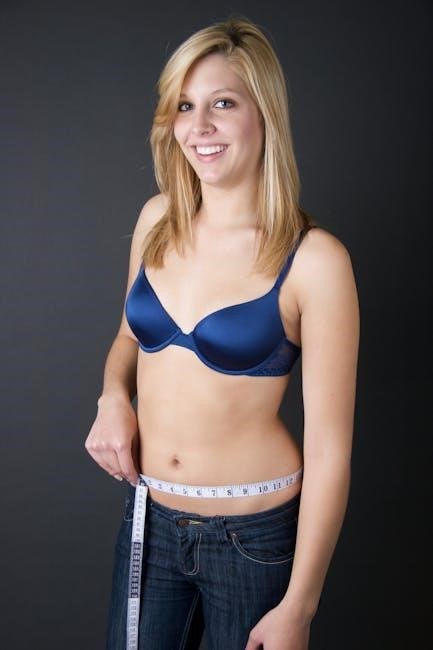Accurate bra measurements are essential for comfort‚ health‚ and style. Understanding your band and cup size ensures proper fit‚ enhancing confidence and reducing discomfort. Learn how to measure correctly for the perfect fit.
1.1 Importance of Proper Bra Fit
A proper bra fit is crucial for comfort‚ health‚ and confidence. Ill-fitting bras can cause discomfort‚ poor posture‚ and even long-term health issues like backaches. The right fit ensures optimal support‚ prevents breast strain‚ and enhances overall appearance. Wearing the correct size boosts confidence‚ improves mobility‚ and reduces the risk of skin irritation. Proper fit is essential for both daily comfort and long-term well-being.
1.2 Overview of Bra Size Components: Band and Cup
Bra sizes consist of two main components: the band and the cup. The band size is measured around the torso‚ just under the bust‚ and provides the primary support. The cup size indicates the volume of the breasts‚ calculated by subtracting the band measurement from the bust measurement. Together‚ they ensure a personalized fit‚ with the band offering stability and the cup providing coverage and shape.
How to Prepare for Measuring
Wear a non-padded‚ well-fitting bra and gather a soft tape measure. Stand straight‚ relax your shoulders‚ and ensure the tape is level for accurate results.
2.1 What to Wear During Measurement
For accurate measurements‚ wear a non-padded‚ unpadded‚ or lightly-lined bra that fits well and mirrors your natural breast shape. Avoid tight clothing that could restrict movement or distort the fit; Stand upright with relaxed shoulders to ensure the tape measure lies flat and level‚ providing precise band and cup size calculations.
2.2 Tools Needed for Accurate Measurements
A soft‚ flexible measuring tape is essential for precise bra measurements. Place it directly on your skin‚ ensuring it’s level and snug but not too tight. A non-padded bra is ideal for accurate sizing. If a tape measure isn’t available‚ some smartphone apps offer alternatives for measuring. Ensure the tape lies flat for both underbust and bust measurements to achieve the most accurate results.
Measuring Your Underbust Size
Wrap a soft tape measure snugly around your torso‚ directly under your bust‚ ensuring it’s level and not too tight. This gives your band size for accurate bra fit.
3.1 Step-by-Step Guide to Measuring Your Band Size
Wear a non-padded bra and stand straight. 2. Wrap a soft tape measure under your bust‚ aligning it horizontally. 3. Ensure the tape is snug but not tight. 4. Breathe out naturally to relax your torso. 5. Record the measurement in inches or centimeters. This provides your band size for accurate bra fitting.
3.2 Understanding Band Size Charts
Band size charts convert underbust measurements into standardized sizes. Measure under your bust‚ ensuring the tape is snug and level. If the measurement is even‚ it’s your band size. For odd numbers‚ round up. Charts vary by brand‚ so refer to specific guides. Sister sizes may offer alternative fits‚ ensuring comfort and support. Use charts to find your perfect band fit effortlessly.
Measuring Your Bust Size
Measure around the fullest part of your bust with a soft tape measure. Keep the tape level and snug‚ ensuring accurate results for your cup size calculation.
4.1 How to Measure Around the Fullest Part of Your Bust
Stand straight with your arms at your sides. Wrap a soft tape measure around the fullest part of your bust‚ keeping it level and parallel to the floor. Ensure the tape is snug but not too tight‚ forming a comfortable fit. This measurement will help determine your cup size accurately for the perfect bra fit.
4.2 Calculating Your Cup Size
Subtract your band size from your bust measurement to determine your cup size. Each inch represents a cup size: 1 inch = A‚ 2 inches = B‚ 3 inches = C‚ and so on. This calculation ensures a precise fit‚ guiding you to the correct cup size for comfort and support in your bra.

Determining Your Bra Size
Combine your band and cup measurements to find your bra size. Subtract band size from bust measurement; each inch difference determines cup size for a perfect fit.
5.1 Subtracting Band Size from Bust Measurement
To determine cup size‚ subtract the band size from the bust measurement. Each inch represents a cup size increment (e.g.‚ 1″ = A‚ 2″ = B). If the result is 0 or negative‚ consider sister sizes for the best fit. For example‚ a 2″ difference means a B cup‚ while a 4″ difference is a D cup. This calculation ensures accurate sizing for comfort and support.
5.2 Interpreting the Results for Your Bra Size
Once you have your band and cup measurements‚ combine them to determine your bra size. For example‚ a 34″ band and 36″ bust measurement results in a B cup (2″ difference). If the difference is 0 or negative‚ consider sister sizes. Use a bra size chart to confirm your size and explore styles that suit your body type for optimal comfort and support.
Understanding Sister Sizes
Sister sizes share the same cup capacity but differ in band size. For example‚ a 34B and 36A are sister sizes‚ offering similar fit with adjusted bands.
6.1 What Are Sister Sizes?
Sister sizes are bra sizes that share the same cup volume but differ in band size. For example‚ a 34B and a 36A are sister sizes‚ offering the same cup fit but with varying band lengths. This concept helps individuals find a more comfortable fit by adjusting the band size without altering the cup size‚ ensuring optimal support and comfort.
6.2 How to Find Your Sister Sizes
To find your sister sizes‚ adjust the band size up or down while changing the cup size inversely. For example‚ a 34B’s sister sizes are 36A and 32C. Use a bra size chart or calculator to identify equivalent cup volumes across different band sizes. This method helps maintain the same cup fit while exploring more comfortable band sizes‚ enhancing overall bra comfort and support.

Common Mistakes to Avoid
Common mistakes include incorrect posture‚ wearing the wrong bra‚ and improper tape measure positioning. Ensure correct stance‚ wear a non-padded bra‚ and keep the tape level for accurate results.
7.1 Incorrect Posture During Measurement
Incorrect posture can significantly affect bra measurements. Slouching or leaning can cause inaccurate readings. Stand straight with arms at your sides to ensure the tape measure lies flat and level. Avoid arching your back or hunching over‚ as this can distort both band and cup measurements. Proper posture guarantees precise results for a perfect fit.
7.2 Wearing the Wrong Bra While Measuring
Wearing a bra that is too tight‚ too loose‚ or heavily padded can distort measurements. Opt for a non-padded‚ lightly-lined bra that mirrors your natural shape. Avoid push-up or minimize bras‚ as they alter bust contours. Ensure the bra band is snug but not constricting to get accurate readings for both band and cup sizes.

Tips for Accurate Measurements
Ensure the tape measure is level and snug but not tight. Measure at the same time daily‚ avoiding fluctuations. Stand straight for consistent results and accuracy.
8.1 Measuring at the Right Time of Day
For consistent results‚ measure your bra size in the morning when your body is at its most relaxed state. Avoid measuring after exercise or at the end of the day when swelling may occur. This ensures accuracy and helps maintain a consistent fit throughout the day.
8.2 Ensuring the Tape Measure is Level
Keeping the tape measure level is crucial for accurate bra measurements. Ensure it remains parallel to the floor and evenly wraps around your torso. Avoid tilting it upward or downward‚ as this can lead to incorrect sizing. Proper alignment guarantees a comfortable and supportive fit‚ making your bra-wearing experience more enjoyable and hassle-free.
Bra Size Charts and Conversion
Bra size charts provide standardized measurements for band and cup sizes. International conversions help compare sizes across regions. Use these charts to interpret your measurements accurately for the perfect fit.
9.1 Standard Bra Size Charts
Standard bra size charts categorize sizes based on band and cup measurements. They provide a consistent reference for determining your size‚ ensuring accuracy. Charts typically list band sizes (e.g.‚ 32-42) and cup sizes (A-DD+). By aligning your measurements with the chart‚ you can identify your ideal fit. These charts are widely used across brands‚ offering a reliable guide for selecting the perfect bra size.
9.2 International Size Conversions
International size conversions help bridge sizing differences across regions. For example‚ a US 32B is equivalent to a UK 32B or EU 70B. Charts or calculators map band and cup sizes globally‚ ensuring consistency. This allows for seamless shopping across brands from different countries‚ maintaining the same fit and comfort regardless of regional sizing standards.
Using a Bra Size Calculator
A bra size calculator simplifies measuring by using band and cup sizes to determine your ideal fit‚ making online shopping easy and accurate every time.
10.1 How Online Bra Size Calculators Work
Online bra size calculators use your band and cup measurements to determine your ideal bra size. Simply input your underbust and bust measurements‚ and the calculator applies a standardized formula to calculate your size. This tool leverages pre-programmed algorithms to ensure accuracy‚ providing instant results. Many calculators also offer size conversions and style recommendations‚ making the process quick and user-friendly for everyone.
10.2 Reliability of Digital Tools
Digital bra size calculators are highly reliable when used correctly. They rely on standardized algorithms to process your measurements‚ ensuring consistency. However‚ accuracy depends on input precision. While these tools simplify the process‚ they may not account for unique body shapes or fabric stretches. Regular updates and adherence to international sizing standards enhance their reliability‚ making them a trusted resource for most users seeking accurate bra sizes.

Special Considerations
Unique breast shapes and sizes require tailored approaches for accurate measurements. Factors like asymmetry‚ prosthetics‚ or rare sizes demand personalized fitting techniques for optimal comfort and support.
11.1 Measuring for Different Breast Shapes
Different breast shapes‚ such as round‚ teardrop‚ or asymmetrical‚ may require adjustments in how measurements are taken. For asymmetrical breasts‚ measure the larger side for accuracy. Round breasts fit standard cups‚ while teardrop shapes may need slightly different band sizing. Ensure the tape measure is level and snug to capture the true dimensions of your unique shape for a perfect fit and comfort.
11.2 Fittings for Unique or Hard-to-Find Sizes
For unique or hard-to-find sizes‚ professional fittings are recommended to ensure accuracy and comfort. Some brands offer custom or made-to-measure options for uncommon band and cup combinations. Online bra size calculators and sister size charts can also help identify alternative sizes. Don’t hesitate to explore different brands‚ as sizing can vary. Prioritize comfort and support to maintain confidence and proper posture‚ regardless of size.
Accurate bra measurements lead to a perfect fit‚ enhancing comfort and confidence. Use the guide’s steps to ensure proper sizing and avoid discomfort or health issues.
12.1 Summary of Key Measurement Steps
Measure your underbust by wrapping a tape measure snugly around your torso. Measure your bust at the fullest point. Subtract the band size from the bust measurement to determine your cup size. Use a size chart or calculator to find your perfect fit. Ensure accurate measurements for comfort and support. Regularly check your size as body changes occur. Proper fit enhances confidence and reduces discomfort. Consistency is key to maintaining the ideal bra fit.
12.2 Final Tips for Maintaining the Perfect Fit
Regularly check your bra fit as body changes occur. Replace bras when they show wear or lose shape. Ensure proper posture during measurements for accuracy. Store bras correctly to maintain their form. Consider seasonal adjustments‚ as weight fluctuations may affect size. Invest in high-quality bras for durability and comfort. Confidence and support start with a well-fitting bra‚ so prioritize regular check-ins to maintain your perfect fit.



0 Comments